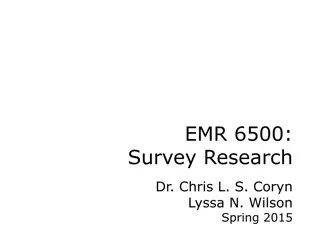Understanding Sampling Methods in Statistical Analysis
Sampling is a crucial process in statistical analysis where observations are taken from a larger population. Different sampling techniques are used based on the analysis being performed. Sampling methods help in studying populations when studying the entire population is not feasible. There are two main types of sampling designs: probability (random) sampling and non-probability (non-random) sampling, each with its own subtypes.
- Sampling methods
- Statistical analysis
- Probability sampling
- Non-probability sampling
- Population study
Download Presentation

Please find below an Image/Link to download the presentation.
The content on the website is provided AS IS for your information and personal use only. It may not be sold, licensed, or shared on other websites without obtaining consent from the author. Download presentation by click this link. If you encounter any issues during the download, it is possible that the publisher has removed the file from their server.
E N D
Presentation Transcript
SAMPLING SAMPLING IS A PROCESS USED IN STATISTICAL ANALYSIS IN WHICH A PREDETERMINED NUMBER OF OBSERVATIONS ARE TAKEN FROM A LARGER POPULATION. THE METHODOLOGY USED TO SAMPLE FROM A LARGER POPULATION DEPENDS ON THE TYPE OF ANALYSIS BEING PERFORMED, BUT IT MAY INCLUDE SIMPLE RANDOM SAMPLING OR SYSTEMATIC SAMPLING.
In Statistics, the sampling method or sampling technique is the process of studying the population by gathering information and analyzing that data. It is the basis of the data where the sample space is enormous. There are several different sampling techniques available, and they can be subdivided into two groups. All these methods of sampling may involve specifically targeting hard or approach to reach groups.
NATURE OF SAMPLING A population is the entire set of persons, objects, events or entities that a researcher intends to study. However, in many instances a population study may not be feasible so the researcher selects a sample or a subset of a target population. Sampling method refer to the different ways of selecting the sample from the target population. Some sampling method aims at obtaining a sample that is representative of the target population. Generalising the study results to the rest of the target population can then be made. However if a sample is biased, generalising from the sample to the population may be less valid or lead to incorrect inference.
TYPES OF SAMPLING Sampling design refers to the process of selecting samples from a population. There are two types of sampling designs. Probability or Random sampling Probability or Random sampling Non Non- -probability or Non probability or Non- -random sampling random sampling
Probability sampling is of following types: Simple random sampling Stratified random sampling Systematic random sampling Cluster sampling
non - Probability sampling is of following types: Convenience or accidental sampling Purposive (or Judgement) sampling Quota sampling Snow-ball sampling























